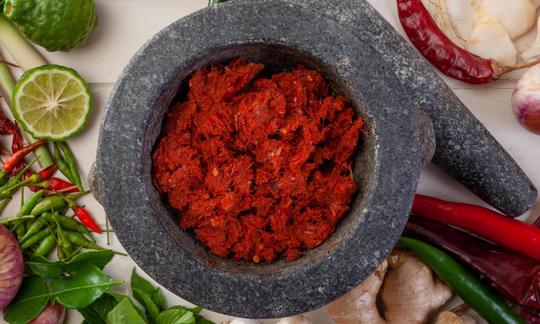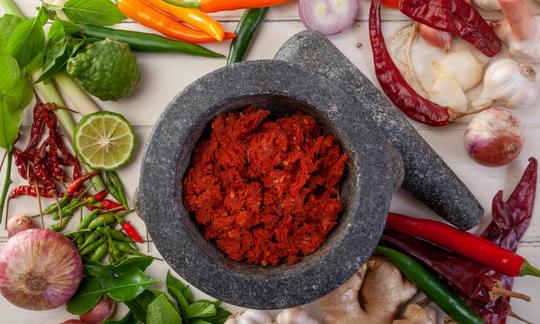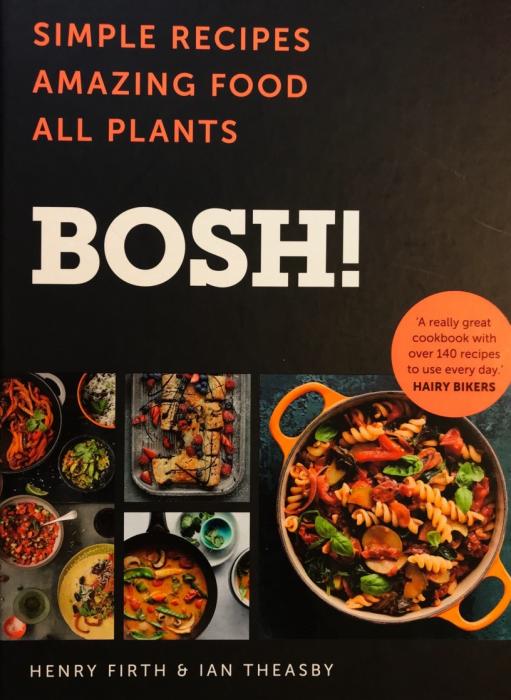Red Thai curry paste with ginger and kaffir lime leaves
vegan
Ingredients (for servings, )
| 1 tsp | Cumin, seeds (raw, organic?) (0.07 oz) |
| 2 tbsp | Real coriander, seeds (raw?, organic?) (0.35 oz) |
| 2 cm | Ginger, raw (organic?) (0.76 oz) |
| 5 | Shallots, raw (organic?) (3.5 oz) |
| 5 cloves | Garlic (organic?) (0.53 oz) |
| 2 stalks | Lemongrass, West Indian or Guatemalan lemongrass (1.8 oz) |
| 3 | Chili peppers, red, raw (organic?) (0.53 oz) |
| 1 tsp, whole | Black pepper (organic?, raw?) (0.10 oz) |
| ½ | Sweet peppers, red, raw (organic?) (2.9 oz) |
| 2 tbsp | Tomato paste, unsalted (organic?, raw?) (1.1 oz) |
| 3 | Kaffir lime leaves, raw (Kaffir leaves, organic?) (0.02 oz) |
| ½ | Limes, raw (organic?) (1.2 oz) |
| ⅓ oz | Coriander leaves, raw |
| 1 dash | Table salt (table salt, raw?, organic?) (0.01 oz) |
| 50 ml | Drinking water, raw (organic?) (1.8 oz) |
Equipment
- blender
- skillet (frying pan)
- stove
- citrus juicer (lemon squeezer)
- freezer
Type of preparation
- chop or grind
- blend
- squeeze
- put on ice
- dry roast
- remove the skin
Preparation
Preparation
Put the cumin and coriander seeds in a pan and roast for about 2 minutes. Scrape the skin off the ginger with a spoon (alternatively with a knife) and roughly chop the rhizome. Peel the solanum and roughly chop it. Peel the garlic. Roughly chop the lemongrass. Remove the stems of the chilies and, if you like it less spicy, the chili seeds.The original recipe also includes an optional birdseye chili (very hot).
preparation
Place the roasted seeds in a blender or food processor along with the ginger, shallots, garlic and lemongrass. Add the fresh chillies, peppercorns, paprika, tomato paste and lime leaves.In the original recipe, the author uses roasted red peppers from a jar. Tips for making your own can be found under "Alternative preparation".
Squeeze half a lime and add the juice to the blender. Wash the fresh coriander and add the leaves. Add salt and a little water (up to a maximum of 50 ml) and blend until you get a fine paste.
The original recipe uses 2 teaspoons of salt for our 12-serving recipe (see tips).
storage
Remove the desired amount and freeze the rest in portions of up to 100 g.The paste will keep for up to 2 months when frozen, so it's easy to prepare in advance.
|
Nutritional Information per person
Convert per 100g
|
2000 kcal | |
|---|---|---|
| Energy | 23 kcal | 1.2% |
| Fat/Lipids | 0.29 g | 0.4% |
| Saturated Fats | 0.03 g | 0.2% |
| Carbohydrates (inc.dietary fiber) | 5.2 g | 1.9% |
| Sugars | 1.4 g | 1.6% |
| Fiber | 1.1 g | 4.5% |
| Protein/Albumin | 0.80 g | 1.6% |
| Cooking Salt (Na:17.8 mg) | 45 mg | 1.9% |
| Essential micronutrients with the highest proportions | per person | 2000 kcal | |
|---|---|---|---|
| Min | Manganese, Mn | 0.34 mg | 17.0% |
| Vit | Vitamin C (ascorbic acid) | 14 mg | 17.0% |
| Elem | Potassium, K | 140 mg | 7.0% |
| Min | Iron, Fe | 0.90 mg | 6.0% |
| Min | Copper, Cu | 0.06 mg | 6.0% |
| Vit | Vitamin B6 (pyridoxine) | 0.09 mg | 6.0% |
| Vit | Vitamin K | 3.9 µg | 5.0% |
| Vit | Folate, as the active form of folic acid (née vitamin B9 and | 11 µg | 5.0% |
| Elem | Calcium, Ca | 20 mg | 3.0% |
| Elem | Magnesium, Mg | 12 mg | 3.0% |
Detailed Nutritional Information per Person for this Recipe
The majority of the nutritional information comes from the USDA (US Department of Agriculture). This means that the information for natural products is often incomplete or only given within broader categories, whereas in most cases products made from these have more complete information displayed.
If we take flaxseed, for example, the important essential amino acid ALA (omega-3) is only included in an overarching category whereas for flaxseed oil ALA is listed specifically. In time, we will be able to change this, but it will require a lot of work. An “i” appears behind ingredients that have been adjusted and an explanation appears when you hover over this symbol.
For Erb Muesli, the original calculations resulted in 48 % of the daily requirement of ALA — but with the correction, we see that the muesli actually covers >100 % of the necessary recommendation for the omega-3 fatty acid ALA. Our goal is to eventually be able to compare the nutritional value of our recipes with those that are used in conventional western lifestyles.
| Essential fatty acids | per person | 2000 kcal |
|---|---|---|
| Alpha-Linolenic acid; ALA; 18:3 omega-3 | 0.01 g | < 0.1% |
| Linoleic acid; LA; 18:2 omega-6 | 0.05 g | < 0.1% |
| Essential amino acids | per person | 2000 kcal |
|---|---|---|
| Tryptophan (Trp, W) | 0.01 g | 2.0% |
| Threonine (Thr, T) | 0.02 g | 2.0% |
| Isoleucine (Ile, I) | 0.02 g | 1.0% |
| Leucine (Leu, L) | 0.03 g | 1.0% |
| Lysine (Lys, K) | 0.02 g | 1.0% |
| Methionine (Met, M) | 0.00 g | 1.0% |
| Phenylalanine (Phe, F) | 0.02 g | 1.0% |
| Valine (Val, V) | 0.02 g | 1.0% |
| Vitamins | per person | 2000 kcal |
|---|---|---|
| Vitamin C (ascorbic acid) | 14 mg | 17.0% |
| Vitamin B6 (pyridoxine) | 0.09 mg | 6.0% |
| Vitamin K | 3.9 µg | 5.0% |
| Folate, as the active form of folic acid (née vitamin B9 and | 11 µg | 5.0% |
| Thiamine (vitamin B1) | 0.02 mg | 2.0% |
| Riboflavin (vitamin B2) | 0.03 mg | 2.0% |
| Niacin (née vitamin B3) | 0.29 mg | 2.0% |
| Vitamin A, as RAE | 16 µg | 2.0% |
| Vitamin E, as a-TEs | 0.28 mg | 2.0% |
| Pantothenic acid (vitamin B5) | 0.08 mg | 1.0% |
| Biotin (ex vitamin B7, H) | 0.40 µg | 1.0% |
| Essential macroelements (macronutrients) | per person | 2000 kcal |
|---|---|---|
| Potassium, K | 140 mg | 7.0% |
| Calcium, Ca | 20 mg | 3.0% |
| Magnesium, Mg | 12 mg | 3.0% |
| Phosphorus, P | 22 mg | 3.0% |
| Sodium, Na | 18 mg | 2.0% |
| Essential trace elements (micronutrients) | per person | 2000 kcal |
|---|---|---|
| Manganese, Mn | 0.34 mg | 17.0% |
| Iron, Fe | 0.90 mg | 6.0% |
| Copper, Cu | 0.06 mg | 6.0% |
| Zinc, Zn | 0.24 mg | 2.0% |
| Selenium, Se | 0.73 µg | 1.0% |
| Fluorine, F | 3.7 µg | < 0.1% |
| Iod, I (Jod, J) | 0.25 µg | < 0.1% |
Bosh! – Simple Recipes – Amazing Food – contains vegan versions of international classics. The recipes are designed so that they can be made quickly and easily.
OverviewIn their book Bosh! – Simple Recipes – Amazing Food – All Plants, Henry Firth and Ian Theasby show how you can easily prepare classic dishes without animal products. The dishes are designed to be quick and uncomplicated and as such often call for canned and convenience foods. The dishes would be healthier if only fresh ingredients were used and attention were given to the nutritional value of the ingredients.
|
Critical book reviews |
SummaryThe cookbook Bosh! – Simple Recipes – Amazing Food – All Plants contains mainly vegan versions of classic international dishes. About two-thirds of the recipes call for canned or convenience products such as puff pastry or premade sauces, which cuts down on the required preparation time. Many of the ingredients include vegan alternatives to dairy products such as vegan butter or cheese. The majority of the dishes contain added oil, and often in larger quantities. About half of the recipes call for sweeteners but only in smaller amounts — with the exception of the desserts. The attractive photos for each recipe give readers a good idea of what to expect. However, preparation times are not included, which makes planning a bit more difficult.
In their cookbook Bosh! – Simple Recipes – Amazing Food –All Plants, Henry Firth and Ian Theasby have included a nice selection of recipes that can be used for everyday cooking. Their adaptations of classic, international recipes make it clear that it is just as easy to make plant-based versions of these traditional dishes. The authors have made it a priority to include recipes that are suitable for everyday cooking. As a result, the nutritional value of the recipes is not always as high as it could be. Bosh! – Simple Recipes – Amazing Food –All Plants by Henry Firth and Ian Theasby is available in German and English on Amazon and from Harper Collins Publishers. They also have a new book called BOSH! Healthy Vegan, which is currently only available in English (also on Amazon and from Harper Collins Publishers).
About the authorsAs a result of their desire to protect the environment, Henry Firth and Ian Theasby began to eat a plant-based diet in 2015. Then in 2016 the two founded Bosh!, a cooking channel that became an online global phenomenon within a year after its launch. In 2018, they published their first cookbook.
ContentsBosh! begins with an introduction and then a chapter titled “Kitchen,” which provides readers with several tips on preparing the dishes. These include helpful kitchen tools and how to use some of the main ingredients. The chapter “Fantastic Feasts” contains suggested menus that are organized based on cuisine and occasions.
The recipes are divided into eight sections:
- Quick eats
- Big eats
- Showpieces
- Greens and Bosh! Bowls
- Small Plates & Sharers
- Cocktails
- Desserts
- Breakfasts
Recipes
Quick eats: These international recipes include lots of noodles as well as rice- and bean-based dishes and a few sauces. Examples are Mushroom Pho and Quick Puttanesca Spaghetti.
Big eats: This section includes vegan versions of classic dishes such as Irresistible Risotto with asparagus and kale, Tom Yum Soup, and Rogan Bosh!, a variation of kashmiri curry.
Showpieces:You will also find international dishes in this section and only a few of them are more complicated and time-intensive such as Spiral Tart and Big Bosh! Roast, a mushroom Wellington.
Greens and Bosh! Bowls: This shorter section contains salads and bowls, for example, Beetroot, Onion & Sweet Potato Salad.
Small Plates & Sharers:From hummus and dips to finger food and small plates, you will find the recipe you want for your next appetizer or side dish in this largest section of the cookbook. Cauliflower Buffalo Wings and Maki Sushi Rolls are just two examples of recipes here.
Cocktails:You can look forward to a small selection of cocktails in this section ranging from classics to new creations. Salted Caramel Espresso Martini is just one example.
Desserts: In this section, you will find mostly baked desserts such as Spanish Beach Churros and Apple Pear Tart.
Breakfasts:Try out these breakfast recipes ranging from hearty to sweet, for example, Creamy mushroom Toast and Turmeric Powershot.
Bosh! – Simple Recipes-Amazing Food-All Plants closes with a chapter on the most important nutrients, their sources, and a recipe index.
Book review written by Dr. med. vet. Inke Weissenborn
The red Thai curry paste with ginger and kaffir lime leaves serves as a base for Thai red curry or Tom Yum soup.
Nutrient profile: Since this preparation is a "basic ingredient" of which you only consume small portions, we will not go into the nutrient composition in detail. Detailed information can be found in the "Nutrient tables" under "Preparation".
Cumin: Despite the similar name, cumin is not closely related to caraway and also differs greatly in taste. Ground cumin has a fresh and slightly spicy aroma, which it owes to the cuminaldehyde contained in the essential oil.
Coriander seeds: Coriander seeds contain 60% of the oil contained in the plant. Among others, linalool and geraniol are particularly responsible for the pleasant smell of coriander seeds, which only becomes apparent after drying.
Ginger: The ginger rhizome has an aromatic smell and a sharp, spicy taste, which is due to the substance gingerol, which is said to have anti-carcinogenic and anti-inflammatory effects. The substances borneol and cineole give ginger its digestive, antiemetic, appetite-stimulating and circulatory properties.
Lemongrass: Lemongrass, also known as "lemon grass", has a reed-like appearance and develops its lemony taste best when eaten fresh. Essential oils are responsible for the intense scent, which is why the lemongrass stalks are first pounded soft for many Asian dishes to improve the solubility of the oils.
Kaffir lime: The kaffir lime, also known as kaffir lime, belongs to the citrus family and originally comes from Asia. Its leaves are best used fresh or frozen to flavor dishes. The dried version has much less flavor.
Lime juice: The raw juice of limes, which contains a high amount of vitamin C, can be used to add a lemon flavor to a variety of dishes and drinks. Compared to lemon juice, lime juice has a more pronounced flavor.
Coriander: Opinions vary widely regarding the taste of coriander. Some people react to its intense, slightly soapy aroma with aversion or even nausea. According to statistics in Switzerland, 15% of all allergy sufferers are sensitive to coriander. There is no alternative with a similar taste. Flat-leaf parsley, which looks similar, has a completely different taste.
Salt: The original recipe calls for 2 teaspoons of salt for the recipe we designed for 12 portions. We have deliberately reduced the amount of salt. The aim is to keep the salt content as low as possible without compromising on taste. Since salt requirements vary from person to person, it is best for you to decide for yourself. We would like to recommend the book " Salt, Sugar, Fat " as an interesting read on this topic.
Storage and processing: The paste will keep for up to 2 months when frozen, so it's easy to prepare in advance. Before processing, always sauté the paste in a little oil so that its flavors can fully develop. Then use as described in the Tom Yum soup recipe (page 63 in the same book).
Freezing rare ingredients: Chilies, lemongrass, lime juice and kaffir lime leaves are easy to buy/make in advance and freeze so you always have a supply on hand.
Homemade tomato paste: Unsalted, homemade tomato paste (tomato purée) made from fresh tomatoes is very versatile and can also be used in this recipe. You can find a corresponding recipe at the following link: Homemade tomato paste made from fresh tomatoes.
Make your own roasted red peppers: Halve the peppers and remove the seeds. Place them on a rack in an oven preheated to 220 °C and roast for about 15 minutes.
Alternatively, you can use roasted peppers from a jar, as in the original recipe, or, as we did, use fresh peppers.






